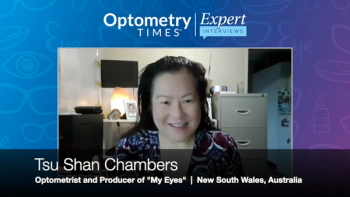
- March Digital Edition 2020
- Volume 12
- Issue 3
Use dark adaptation to screen before multifocal IOL implantation
Identifying patients with early AMD is necessary to avoid suboptimal surgical outcomes
Various factors, including a compounded reduction in contrast sensitivity and reduced reading speed, mean that multifocal IOLs are not ideal for patients with early or subclinical AMD. It is therefore imperative to identify such patients-using a simple practice tool-and enable them to make an informed choice preoperatively.
The symptoms of age-related macular degeneration (AMD) and cataract are quite similar, with night vision difficulties being a common finding in both conditions. A standard comprehensive eye exam will usually determine which disease is driving the symptomatology in patients with intermediate to late-stage AMD.
However, it is easy to overlook early and subclinical AMD when looking only for drusen. This could put these patients who are considering a multifocal intraocular lens (IOL) at significant risk of less than optimal surgical outcomes.
Related:
Here, we discuss why patients who have early AMD may not be ideal candidates for a multifocal IOL and present a simple practice tool for identifying early disease so that patients and surgeons can make better informed choices preoperatively.
Multifocals compound risk in AMD patients
Multifocal lenses help patients see at different distances by splitting light into multiple foci. The tradeoff for visual improvement at both distance and near is an expected (but hopefully mild) reduction in contrast sensitivity. However, because macular degeneration and multifocal IOLs both reduce patients’ contrast sensitivity, one would face a compounded reduction in contrast sensitivity and perhaps decreased visual outcomes.1
Beyond contrast sensitivity, good macular function is also required to achieve normal reading speed with multifocal IOLs,1 which again should urge us to look more carefully for any signs of AMD.
Related:
In short, implanting a multifocal in a patient with AMD is risky and the outcomes may not be acceptable to patients who likely have very high expectations because they are paying out of pocket for a premium procedure.
At the very least, these patients deserve more in-depth counseling, and ODs should carefully consider and emphasize the informed consent.
Minimize risk by assessing macular function
Structural signs of macular degeneration, at any stage, can be difficult to view or detect,2 and through a cloudy cataract this task is likely to be even more difficult. However, the need to identify these patients using any means necessary cannot be overstated.
Related:
In a 2014 report, the American Society of Cataract and Refractive Surgeons (ASCRS) Cataract Clinical Committee noted that photostress testing is useful for assessing macular function in multifocal IOL candidates.1
Since the publication of this report, the AdaptDx dark adaptometer (MacuLogix) has been commercialized, improving the objectivity of this type of testing and providing measurable data to further assist in patient selection. The test is easy for technicians to learn, no pupil dilation is needed, and test results are not impacted by the presence of cataracts. While continuously focusing on a fixation light, patients are exposed to a mild bleaching flash and then asked to indicate when a progressively dimmer stimulus light appears.
The AdaptDx can detect subclinical AMD at least three years earlier than it is clinically evident.3 It works by measuring a patient’s rod intercept (RI) time: the number of minutes it takes for the eye to adapt from bright light to darkness. This RI number provides a clear and objective measurement of retinal function with 90 percent sensitivity and specificity.4 Basically, an RI of less than 6.5 minutes indicates a healthy dark adaptation function and no signs of AMD. However, an RI higher than 6.5 indicates impaired dark adaptation.
Related:
How many patients can you protect?
Shortly after the first AdaptDx was put in practice, Marta McKeague, MD, and Mark Pyfer, MD, conducted a study and presented the results at the XXXIV Congress of the European Society of Cataract and Refractive Surgeons.5 Asserting that screening is needed since multifocal intraocular lenseIOLs may reduce contrast sensitivity and impair visual function in patients with subclinical macular disease, the researchers set out to determine whether dark adaptation could be used as a screening method in patients undergoing cataract surgery evaluation.
Their retrospective chart review was conducted in a comprehensive ophthalmology practice and identified 193 patients who underwent dark adaptation testing within a 13-month period. A total of 27 patients had both a normal fundus exam and normal corneal topography, making them candidates for multifocal IOLs.
Related:
Of these 27 eyes, 17 (63 percent) had normal dark adaptation and 10 (37 percent) had abnormal dark adaptation. In other words, if all 27 of these patients opted to undergo cataract surgery with a multifocal IOL, more than one-third of them would potentially experience problems that could not have been anticipated if dark adaptation had not been measured preoperatively.
These results are consistent with research in our own practices. For example, at Grin Eye Care, we looked at a series of 100 consecutive patients over the age of 60 with no clinical findings of AMD based on dilated fundus exam and optical coherence tomography (OCT). At the end of the study, 61 participants had normal dark adaptation, and 39 participants had impaired dark adaptation, meaning that almost 40 percent of seemingly healthy patients over the age of 60 had macular function disorders that could affect their candidacy for a multifocal IOL.
Loss of contrast sensitivity is present even in mild forms of AMD, making implantation of a multifocal IOL a relative contraindication6-or at least a reason to proceed with extreme caution. As these studies indicate, structural testing alone is not sufficient to screen patients for early AMD that will likely impact cataract outcomes. For this reason, macular function testing using the AdaptDx dark adaptometer can provide optometrists with essential information prior to referring patients for premium cataract surgery.
More by Dr. Gerson:
References:
1. Braga-Mele R, Chang D, Dewey S, Foster G, Henderson BA, Hill W, Hoffman R, Little B, Mamalis N, Oetting T, Serafano D, Talley-Rostov A, Vasavada A, Yoo S; ASCRS Cataract Clinical Committee. `Multifocal intraocular lenses: relative indications and contraindications for implantation. J Cataract Refract Surg. 2014 Feb;40(2):313-22.
2. Neely DC, Bray KJ, Huisingh CE, Clark ME, McGwin G Jr, Owsley C. Prevalence of Undiagnosed Age-Related Macular Degeneration in Primary Eye Care. JAMA Ophthalmol. 2017 Jun;135(6):570-575.
3. Owsley C, McGwin G Jr, Clark ME, Jackson GR, Callahan MA, Kline LB, Witherspoon CD, Curcio CA. Delayed Rod-Mediated Dark Adaptation Is a Functional Biomarker for Incident Early Age-Related Macular Degeneration. Ophthalmology. 2016 Feb;123(2):344-5.
4. Jackson GR, Scott IU, Kim IK, Quillen DA, Iannaccone A, Edwards JG. Diagnostic sensitivity and specificity of dark adaptometry for detection of age-related macular degeneration. Invest Ophthalmol Vis Sci. 2014 Mar;55(3):1427-31.
5. McKeague M, Pyfer M. Using dark adaptation time to assess macular function prior to cataract surgery. Paper presented at XXXIV Congress of the European Society of Cataract and Refractive Surgeons Free Paper Session. September 12, 2016.
6. Chakrabarti M, Chakrabarti A. IOL Selection for Patients With Age-Related Macular Degeneration. CRST Europe. Available at: https://crstodayeurope.com/articles/2015-mar/iol-selection-for-patients-with-age-related-macular-degeneration/. Accessed 2/9/20.
Articles in this issue
over 5 years ago
New-onset, atypical retinopathy in a patient with diabetesalmost 6 years ago
Pediatric headache: The vital role of the optometristalmost 6 years ago
Update on iris melanomaalmost 6 years ago
Unconventional clinical options for lowering IOPalmost 6 years ago
Optometry’s year can give ODs an edge with treatmentsalmost 6 years ago
New guidelines out for diabetes patient carealmost 6 years ago
The effect of contoured prism lenses on chronic headaches: a case studyalmost 6 years ago
Optometry’s role in multiple sclerosisalmost 6 years ago
5 tips to keep presbyopes in contact lensesalmost 6 years ago
How to create an ocular surface disease treatment protocolNewsletter
Want more insights like this? Subscribe to Optometry Times and get clinical pearls and practice tips delivered straight to your inbox.













































.png)


